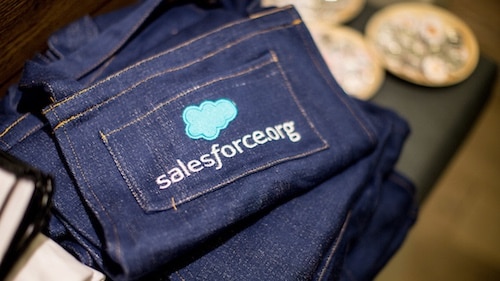In 2019, there were 68.5 million people in the world who had been forcibly displaced from their homes. Every single day in 2018, more than 44,000 people fled their homes due to conflict and persecution. Our global population has the highest number of refugees since World War II.
World Refugee Day aims to educate us about the severity of today’s refugee crisis and inspire us to take action.
At Salesforce, a large part of our culture revolves around giving back and we continuously consider ways we can use technology to make a positive social impact in the world. Our Architect of Ethical AI Practice Kathy Baxter sums up our efforts around using technology for good by saying technology “should be in service of the human, not the other way around.”
Blockchain technology for refugee assistance
We’ve taken a deep dive into the topic to answer questions like, “What is blockchain technology?” and “How can blockchain help my business?”
Two of the innovative minds using technology for good, Salesforce’s Master Enterprise Architect Dan Harrison and Principal Solution Engineer Alex Kruglyak, went one step further to answer how blockchain technology can help refugees and third-party organizations that support them.
Harrison and Kruglyak considered different use cases for blockchain. Harrison collaborated with Kruglyak on the project because of Kruglyak’s previous volunteer experience at a refugee camp in Jordan. The Salesforce.org Innovation team had an opportunity to observe first hand the daily operations and processes involved in supporting refugees, and make recommendations on how to improve them.
Inspired by the volunteer work he’d done, Kruglyak came up with the idea to use blockchain to improve information sharing among various organizations such as government agencies, nonprofits, and volunteer organizations that support refugees.
The need for a universal ID for refugees
When a humanitarian crisis strikes and people are forced to flee their homes, they take off in the direction of a safe haven, which often involves crossing borders, or living in a refugee camp.
Harrison designed the concept of a unique universal ID to help government agencies and nonprofit organizations manage the refugee identification process. But, most importantly, Harrison created the technology to help people prior to humanitarian issues that generate a refugee status.
Blockchain technology facilitates the way we share information in a secure, efficient, and transparent way across many different domains. Harrison recognized the opportunity for blockchain technology to help displaced people trust their information is in the right hands.
“Who wants to be giving medical records and identity documents to agencies, which are prime targets for identity theft? The idea is if we can use blockchain, it has a lot bigger capability for trust. We can potentially help people manage their identity before they end up in one of these humanitarian issues and become a refugee,” recalled Harrison about his inspiration behind the universal ID.
“Once you’re in the system, having the universal ID isn’t as big of a negative thing. We’re trying to destigmatize a universal ID. And if everybody has that as a kind of insurance, well, if you use your insurance, that’s not a bad thing. You planned ahead. And having a universal ID is like having security in case something bad happens. Everybody who’s planning ahead has one and it will help protect their family. We thought that it would help destigmatize some of that involvement in the refugee process as well,” said Harrison.
The verification of critical information in the universal identification process is time-sensitive and requires great care and attention to detail. This can leave room for error when information is passed between multiple agencies and organizations.
“The first point of contact for refugees when they flee is a government agency or nonprofit support organization. They’re responsible for identifying those refugees before anybody can give any kind of services or support,” explained Harrison. “Since we are dealing with sensitive refugee data, it’s imperative that trust and security form the basis for any technology. Because blockchain is a digital ledger that is immutable, secure, distributed, and transparent, it serves as a great foundational technology to enable sharing of information among various parties.”
During a humanitarian crisis, government agencies work closely with nonprofit organizations to provide medical care, financial assistance, housing, and employment. “A network of agencies, either government or UN, typically work together. And that’s why blockchain is a great way to coordinate the sensitive refugee information being stored and shared. Blockchain is a distributed database and a trusted environment. These organizations are looking after refugees and helping fulfill their basic needs.”
The responsibility of using technology for good
When people do something as simple as fill out a form online, it’s important to ensure they realize what information is collected and why. “We need to be as transparent as possible,” explained Harrison.
When it comes to collecting more information and applying evaluation or AI to provide help to refugees, we need to work together to ensure we remove human bias by training the technology to catch and remove it. We need to make certain we adopt an ethical mindset when it comes to evolving technology instead of treating ethics as something we need to check off a list in the quality assurance process.
At Salesforce we advocate for the use of emerging technologies like AI or blockchain in the humanitarian context in accordance with humanitarian data ethics published by UN OCHA, ICRC, and other appropriate humanitarian authorities.
Especially when we use technology to help protect the vulnerable, we need to be fully transparent with why we collect their information, who the information will be shared with, and why. With technology like blockchain, we can provide protection for displaced people by ensuring their identity data is stored securely in a way they can easily access.
The responsibility is on us to ensure the evolution of technology heads in a direction where it will be used for good.
Learn more about Blockchain by taking our free, online learning course — Blockchain Basics — over at Trailhead.




























